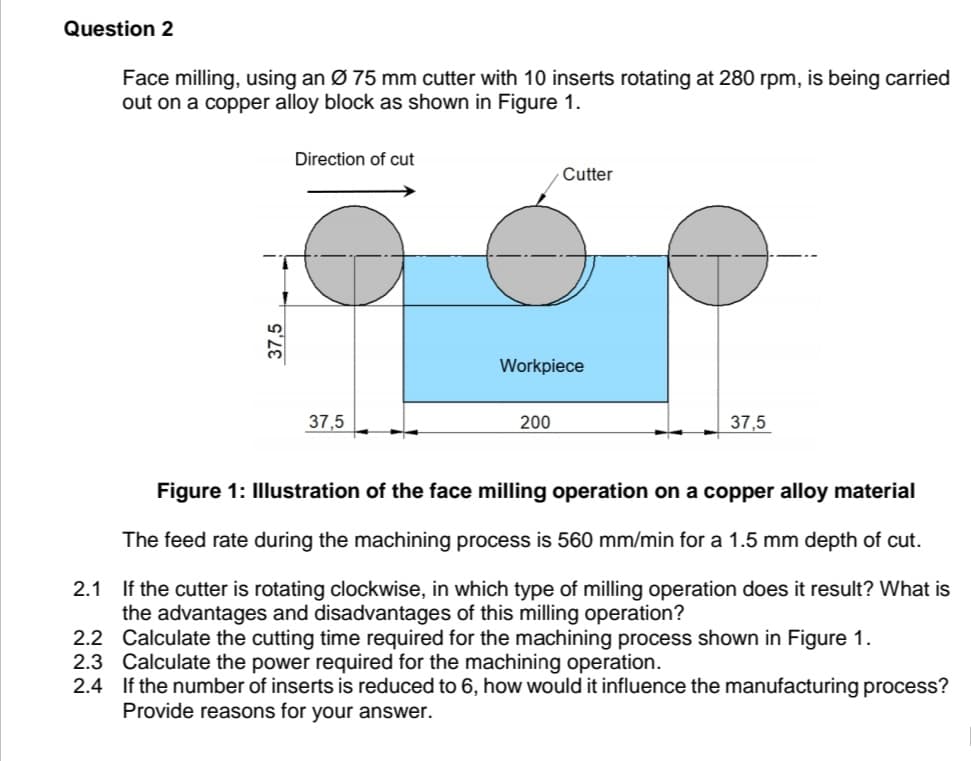Face milling, using an Ø 75 mm cutter with 10 inserts rotating at 280 rpm, is being carried out on a copper alloy block as shown in Figure 1. Direction of cut Cutter Workpiece 37,5 200 37,5 Figure 1: Illustration of the face milling operation on a copper alloy material The feed rate during the machining process is 560 mm/min for a 1.5 mm depth of cut. 2.1 If the cutter is rotating clockwise, in which type of milling operation does it result? What is the advantages and disadvantages of this milling operation? 2.2 Calculate the cutting time required for the machining process shown in Figure 1. 37,5
Face milling, using an Ø 75 mm cutter with 10 inserts rotating at 280 rpm, is being carried out on a copper alloy block as shown in Figure 1. Direction of cut Cutter Workpiece 37,5 200 37,5 Figure 1: Illustration of the face milling operation on a copper alloy material The feed rate during the machining process is 560 mm/min for a 1.5 mm depth of cut. 2.1 If the cutter is rotating clockwise, in which type of milling operation does it result? What is the advantages and disadvantages of this milling operation? 2.2 Calculate the cutting time required for the machining process shown in Figure 1. 37,5
Elements Of Electromagnetics
7th Edition
ISBN:9780190698614
Author:Sadiku, Matthew N. O.
Publisher:Sadiku, Matthew N. O.
ChapterMA: Math Assessment
Section: Chapter Questions
Problem 1.1MA
Related questions
Question
100%

Transcribed Image Text:Question 2
Face milling, using an Ø 75 mm cutter with 10 inserts rotating at 280 rpm, is being carried
out on a copper alloy block as shown in Figure 1.
Direction of cut
Cutter
Workpiece
37,5
200
37,5
Figure 1: Illustration of the face milling operation on a copper alloy material
The feed rate during the machining process is 560 mm/min for a 1.5 mm depth of cut.
2.1 If the cutter is rotating clockwise, in which type of milling operation does it result? What is
the advantages and disadvantages of this milling operation?
2.2 Calculate the cutting time required for the machining process shown in Figure 1.
2.3 Calculate the power required for the machining operation.
2.4 If the number of inserts is reduced to 6, how would it influence the manufacturing process?
Provide reasons for your answer.
Expert Solution
This question has been solved!
Explore an expertly crafted, step-by-step solution for a thorough understanding of key concepts.
Step by step
Solved in 2 steps

Knowledge Booster
Learn more about
Need a deep-dive on the concept behind this application? Look no further. Learn more about this topic, mechanical-engineering and related others by exploring similar questions and additional content below.Recommended textbooks for you

Elements Of Electromagnetics
Mechanical Engineering
ISBN:
9780190698614
Author:
Sadiku, Matthew N. O.
Publisher:
Oxford University Press

Mechanics of Materials (10th Edition)
Mechanical Engineering
ISBN:
9780134319650
Author:
Russell C. Hibbeler
Publisher:
PEARSON

Thermodynamics: An Engineering Approach
Mechanical Engineering
ISBN:
9781259822674
Author:
Yunus A. Cengel Dr., Michael A. Boles
Publisher:
McGraw-Hill Education

Elements Of Electromagnetics
Mechanical Engineering
ISBN:
9780190698614
Author:
Sadiku, Matthew N. O.
Publisher:
Oxford University Press

Mechanics of Materials (10th Edition)
Mechanical Engineering
ISBN:
9780134319650
Author:
Russell C. Hibbeler
Publisher:
PEARSON

Thermodynamics: An Engineering Approach
Mechanical Engineering
ISBN:
9781259822674
Author:
Yunus A. Cengel Dr., Michael A. Boles
Publisher:
McGraw-Hill Education

Control Systems Engineering
Mechanical Engineering
ISBN:
9781118170519
Author:
Norman S. Nise
Publisher:
WILEY

Mechanics of Materials (MindTap Course List)
Mechanical Engineering
ISBN:
9781337093347
Author:
Barry J. Goodno, James M. Gere
Publisher:
Cengage Learning

Engineering Mechanics: Statics
Mechanical Engineering
ISBN:
9781118807330
Author:
James L. Meriam, L. G. Kraige, J. N. Bolton
Publisher:
WILEY